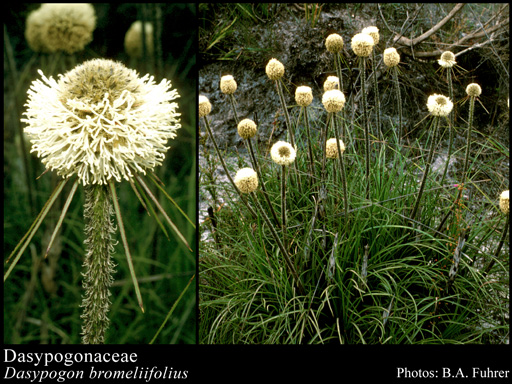- Name Status
- Current

Scientific Description
Common name. Dasypogon Family.
Family Sometimes included in Xanthorrhoeaceae.
Habit and leaf form. ‘Arborescent’, or shrubs, or herbs (less often). Plants with a basal concentration of leaves (more or less acaulescent), or with neither basal nor terminal concentrations of leaves; rhizomatous. Pachycaul. Mesophytic, or xerophytic. Leaves small to large; alternate; spiral (usually), or distichous; leathery, or modified into spines, or ‘herbaceous’; sessile; sheathing. Leaf sheaths not tubular; with free margins. Leaves simple. Leaf blades entire; acicular, or linear; parallel-veined; without cross-venules. Stem anatomy. Secondary thickening absent, or anomalous (and sometimes with compound vascular bundles); from a single cambial ring.
Reproductive type, pollination. Fertile flowers hermaphrodite, or functionally male, or functionally female. Unisexual flowers present, or absent. Plants hermaphrodite, or dioecious.
Inflorescence and flower features. Flowers aggregated in ‘inflorescences’. Inflorescences scapiflorous, or not scapiflorous; elongate and loosely branched, or of globose partial inflorescences, or of dense, multiflorous often globose paniculate or thyrsoid heads. Flowers small; regular; 3 merous; cyclic; pentacyclic. Perigone tube present, or absent. Hypogynous disk absent. Perianth of ‘tepals’; 6; 2 -whorled; isomerous; sepaloid (occasionally), or petaloid (usually); similar in the two whorls, or different in the two whorls; white, or cream, or yellow, or hyaline; fleshy, or non-fleshy. Fertile stamens present, or absent (female flowers). Androecium 6. Androecial members free of the perianth, or free of the perianth and adnate (the three inner members sometimes fused to the bases of the inner tepals); all equal; free of one another; 2 -whorled. Androecium exclusively of fertile stamens. Stamens 6; diplostemonous. Anthers dorsifixed to basifixed; dehiscing via longitudinal slits; introrse. Pollen shed as single grains. Fertile gynoecium present, or absent (male flowers). Gynoecium 3 carpelled. The pistil 1 celled, or 3 celled. Carpels isomerous with the perianth. Gynoecium syncarpous; eu-syncarpous; superior, or inferior. Ovary unilocular, or plurilocular; 1 locular (Dasypogon), or 3 locular. Gynoecium stylate, or non-stylate to stylate. Styles 1 (simple or tribrachiate); attenuate from the ovary, or from a depression at the top of the ovary; apical. Stigmas 1, or 3; 1 - lobed, or 3 - lobed; wet type. Placentation when unilocular, basal; when trilocular, axile. Ovules in the single cavity when unilocular, 1; 1 per locule; non-arillate; anatropous to campylotropous.
Fruit and seed features. Fruit non-fleshy; dehiscent, or indehiscent; a capsule, or capsular-indehiscent. Seeds endospermic. Embryo well differentiated (but often small). Testa without phytomelan (always?). Seedling. Hypocotyl internode present, or absent. Mesocotyl present, or absent. Seedling collar not conspicuous. Coleoptile present. Primary root ephemeral.
Geography, cytology, number of species. Paleotropical and Australian. World distribution: Australian, with Lomandra extending to New Guinea and New Caledonia. X = 7,8, 9. About 60 species.